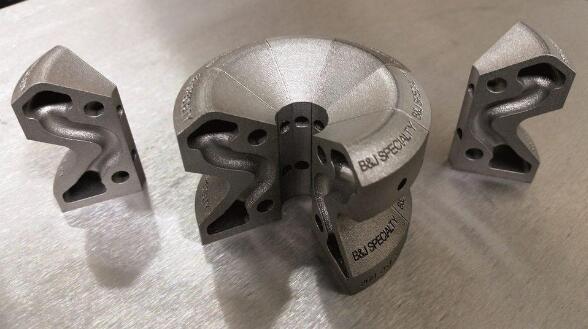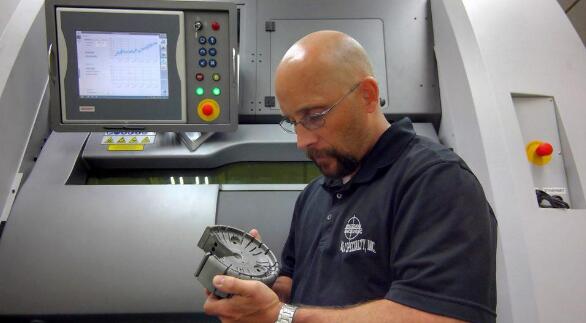B & J Specialty – Making ‘Cooler’ Molds With 3-D Printing
One of the promises of 3-D printing is that it presents the potential to manufacture complex parts that you can’t produce with any other technology. For B & J Specialty, Inc., in Wawaka, Indiana, that potential is being realized right now.
 Cut-away of a metal 3-D printed part revealing the conformal cooling channels, IMAGE COURTESY B & J SPECIALTY, INC.
Cut-away of a metal 3-D printed part revealing the conformal cooling channels, IMAGE COURTESY B & J SPECIALTY, INC.
B & J is an established mold and die manufacturer. The company was founded in 1975 as a father-son business by Robert and John Wicker, along with wife and mother Norma Wicker, and was literally started in a garage. Originally they focused on standard machining applications, but in keeping with their founding value of “making a difference,” they soon moved into their current specialty. They found their niche in providing mold & die tooling designs, fabrication and repair services, primarily for auto part manufacturers, but also for parts producers for household appliances, and they’ve even reverse-engineered custom molds for collector horse models. They’ve grown to about 200 employees today, and are proud that they’ve had almost no turnover in their 40-plus year history.
B & J Specialty’s team members have a mindset to “always do better,” according to their Additive Manufacturing (AM) Design Engineer Jarod Rauch, a 22-year employee. It was that approach that led them to look at 3-D printing. “We first heard of 3-D printing ten years ago, but it wasn’t ‘there’ yet,” said Rauch. The company finally considered the new technology capable enough for investment two years ago, when they purchased their first printer, a 3D Systems ProX DMP 300. “There was a big learning curve, for us and our customers,” Rauch said.
 Jarod Rauch uses metal 3-D printing to create specifically-designed molds and insertsIMAGE COURTESY B & J SPECIALTY, INC.
Jarod Rauch uses metal 3-D printing to create specifically-designed molds and insertsIMAGE COURTESY B & J SPECIALTY, INC.
It was in working through that learning curve, though, that the company discovered the huge advantage of the technology for mold-making. In legacy mold manufacturing, cooling channels – which provide pathways for liquid coolant to flow and solidify the parts being produced – could only be bored straight through the machined metal mold. “The standard way could cause long cycle times or lead to quality problems because of the lack of cooling” said Rauch.
3-D printing specifically-designed molds and inserts, however, allows the coolant pathways to be formed in any shape and direction desired – and AM is the only way these channels can be produced. “It’s called conformal cooling,” Rauch explained. “It allows the cooling passage to follow the shape of the part being made.” This is particularly important for intricate parts, which can be curved and have delicate features that the old straight cooling pathways couldn’t match. The results are impressive. “We average about a 30% increase in productivity, plus part quality improvements, due to the unique shaped cooling passages,” Rauch said.
B & J designs their molds using the specialist design software Cimatron MoldEx 3D, and then prints them using Metal Powder Bed Fusion technology from 3D Systems, in which the design is printed by depositing metal powder and melting it with a focused laser beam layer by layer.
 A typical design simulation of conformally cooled channels developed in the Cimatron softwareIMAGE COURTESY B & J SPECIALTY, INC.
A typical design simulation of conformally cooled channels developed in the Cimatron softwareIMAGE COURTESY B & J SPECIALTY, INC.
To build this part of the business, B & J has to educate its customers, showing them the analysis of the old technology versus the new. “Our customers are very eager to listen to what additive manufacturing is, but very hesitant to want to take that path,” Rauch said. “This is because with additive, you’re not only changing the design of a part, you’re also changing materials and processes customers will use when molding the plastic parts. One of the key topics I explain to our customers that are new to additive is the importance of water quality. With standard designs this wasn’t always a big issue because the internal cooling lines were straight bored holes throughout the metal blocks of steel. If foreign particles or rust start to build up inside you could remove the buildup very easily. Now with conformal cooling channels that follow the three-dimensional shape of the part, this type of buildup cannot be removed so easily. This is why having good water quality is vital for the longevity of a 3-D printed mold that has conformal cooling channels.”
The technology has been a winner for B & J. They’ve steadily built their customer base for 3-D printed molds and dies. In addition to their own customers who’ve moved to the new methods, they’ve also attracted new customers whose previous machine shops don’t offer AM, which has penetrated around 4% of B & J’s business. “I believe by educating customers and encouraging an open mind-set, that number will only continue to grow,” said Rauch.
In addition to the productivity and quality improvements in the basic molding process, 3-D printing offers advantages in its use of a range of materials. Some of the metals now in use allow for heat treatment of the finished molds for hardness, but retain their high thermal conductivity. The parts produced are as resilient, if not more so, than the traditional metals. The addition of the efficient conformal cooling also enhances the lifetime of the mold or insert being used.
Rauch sees future opportunities in the further development of 3-D printing technology. “I think we’ll see an increase in the throughput of the printers – for example, with multiple lasers,” he said. “Right now bigger parts take lots of time.”
He’s sold on the potential of the technology. “Don’t be afraid of change,” he said. “It sounds cliché, but if you get stuck doing things the same way, you’re not always going to succeed. When designing for 3-D printing you have to think about design with no limitations. 3-D printing provides the answer to so many of our everyday problems as a tool and die manufacturer. It can truly change injection molding.”
Source: forbes




Recent Comments